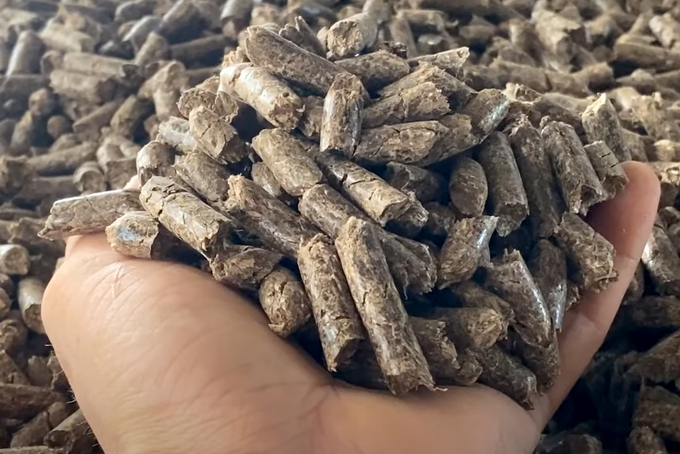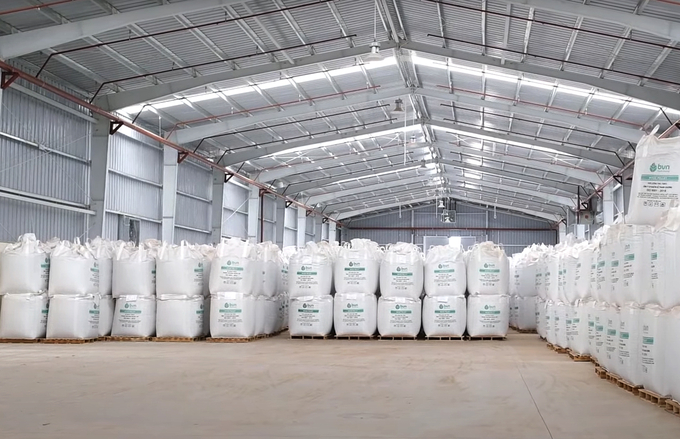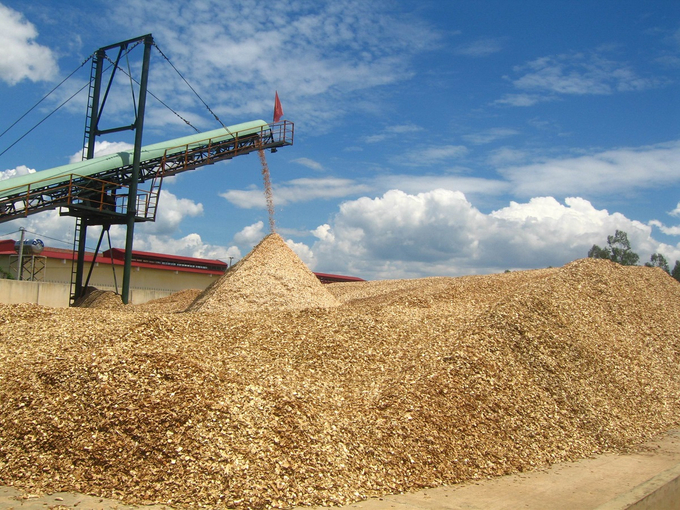In the 10th Energy Plan for the period 2022-2036, the Korean government stipulated that wood pellets will account for 57.64% of all bioenergy, so the demand for imported pellets will increase many times over.

The director of PoSeung Green Power Biomass Power Plant gave an introduction to the operation of the plant. Picture: Chu Khoi.
Steam “lays” money
As part of the study and exchange of international experiences on bioenergy development in Korea program by the organization “Climate Protection through Sustainable Development of Bioenergy Market in Vietnam” (BEM), our delegation visited the PoSeung Green Power Biomass Combined Heat and Power Plant in Asan National Industrial Complex in Poseung (Gyeonggi Province , Korea).
This is a 100% bio solid fuel (Bio-SRF) power plant that will use wood biomass as a fuel source to generate up to 174.3 tons of steam and 43.2 MW of electricity per hour. The construction of the factory started in March 2016 and started commercial operation in March 2018, which is designed to have a service life of 30 years.

A corner of the PoSeung Green Power biomass thermal power station. Picture: Chu Khoi.
PoSeung Green Power Biomass Power Plant director said the total cost of building the plant was US$22 million, including US$6 million in equity and US$16 million borrowed from the project capital. LX International owns 63% of the factory investment capital and the remaining 37% is foreign capital.
Of this $22 million investment, $19 million is for equipment and construction and $3 million is for operating and licensing expenses. The main equipment installed at the factory includes turbines manufactured by GM India, generators imported from India (BHNL) and boilers manufactured by domestic firms. The factory has to bear the cost of land rent for the industrial park of about 100,000 USD/year.
Regarding the operation of the plant, the technical director said that after burning biomass fuel, heat is provided to heat the water in the boiler plant. In the boiler, the water is heated to 500 degrees Celsius to turn it into steam. Some of the steam then enters the turbine and turns the generator, which produces electricity with a capacity of 30 MWh. A slightly different part is separated to supply factories in the industrial area.
The power plant sells electricity to the Korea Electric Power Corporation and steam to companies operating in the Asan National Industrial Complex in Poseung.
Superheated steam is routed via 10 lines to 10 companies in order to enable steam-powered devices and machines to be operated there. The temperature of the steam generated in the plant is 500 degrees Celsius. However, when it reaches the consumer companies, it is only around 200 degrees Celsius, and the condensed steam is then recovered back to the power plant.

Korea will increasingly switch to the use of energy from pellets. Picture: Chu Khoi.
Regarding the off-gas treatment system, the technical staff said that the off-gas generated after the biomass combustion process is reduced to chlorine, sulfur-HCl components and carbonate neutralization. The exhaust gas then flows through the plant, using activated carbon to remove pollutants such as furans and dioxins, and filter devices to remove the dust in the exhaust gas before it is released into the environment.
As for the source of the raw material, the factory director said that the factory uses an average of about 35 tons of fuel per hour. “Currently, due to the Netzero involvement and the Russia-Ukraine conflict, tablet prices are very high. As a result, the factory only uses 10% wood pellets, with the remainder being wood chips from construction waste, household waste and forest by-products such as dry branches and fire-damaged forest trees. Fire…”.
To generate 1 MW of electricity, the plant requires 1.5 tons of biomass. The company consumes around 260,000 tons of biomass every year. Regarding the actual profit efficiency, the director of PoSeung Green Power Biomass Power Plant said: The plant operates continuously 310 days a year, which is 7,400 hours. Around 300,000 MWh of electricity are sold every year. Factory rate of return (IRR) (excluding interest and equipment depreciation) is 10-12%/year and actual IRR is 6-7%/year.
80% of the imported tablets come from Vietnam
dr Lee Soo Min, senior research expert in the Industrial Materials Department, spoke to the Vietnamese delegation participating in the study tour program and shared international experiences on bioenergy development in Korea. According to the National Forest Science Institute of Korea, the country is transitioning energy to meet its commitment to reducing carbon emissions.

Currently, Vietnam is the most important import market for Korean tablets. Picture: tsp.
Currently, biomass energy accounts for less than 1.5% of Korea’s total electricity production. Biomass power in Korea is mainly thermoelectric, which uses pellet materials for combustion and heat generation to generate electricity. Pellet power generation capacity has increased significantly in Korea in recent years, although it accounts for only a very small proportion.
In 2022, the domestic wood pellet market in Korea is 4.5 million tons (including import and domestic production). Of this, domestic production only covers 15.8% of the pellet requirements of power plants in Korea.
Korea currently has about 20 tablet production plants, most of which are small (less than 10,000 tons/year) and only three large, the total production capacity is estimated at 1 million tons/year.
“The import of wood pellets to Korea is 3.78 million tons in 2022, an increase of 600,000 tons compared to 2021. Korea imports 95% of wood pellets from three Southeast Asian countries, Indonesia, Vietnam and Malaysia. Vietnam is an important import market for Korean wood pellets. In 2022, Korea imported 2.2 million tons from Vietnam, accounting for 80% of imports,” said Dr. Lee Soo Min

Korea’s increased use of pellet energy will be a great opportunity for Vietnam. Picture: tsp.
dr Lee Soo Min explained Korea’s dependence on imported pellets from Vietnam as follows: Korea’s territory covers 10 million hectares, of which 6.3 million hectares are forest area and the amount of wood is 4.3 million tons of crude oil per year. Currently, Korea’s annual timber production is only one-tenth that of Vietnam. While Vietnam has a natural land area of 33.8 million hectares, including 14.8 million hectares of forest, the annual production of harvested raw wood is up to 30-57.3 million m3.
Korea will have to import tens of millions of tons of tablets in the future
According to Korean experts, the Korean renewable energy market, including wood pellets, is driven by government policies. In the 10th Energy Plan for the period 2022-2036, the Korean government stipulated that wood pellets will account for 57.64% of all bioenergy.
It is forecast that Korea’s demand for wood pellets will reach 5 million tons in 2023, of which 743,000 tons will be domestic production and 4.17 million tons will be imports.

At present, there are a lot of wood materials in Vietnam, which is a huge space for producing pellets for export to Korea. Picture: tsp.
“In Korea, many power plants that use pellets are still being built, and many factories are in the planning stage. Therefore, the demand for pellets in Korea will continue to increase rapidly in the coming years. Next, it is expected to increase to 6 million tons by 2025,” said Dr. Lee Soo Min
according to dr Lee Soo Min, coal-fired power plants in Korea currently produce almost 40% of the total national electricity production and consume a total of 100 million tons of coal per year. The Korean government plans to phase out coal-fired power generation by 2030.
To implement this policy, there will be coal-fired power plants that will change the technology and convert the equipment to use pellets. If all coal-fired power plants in Korea are converted to pellet thermal power plants, the demand for pellets will be huge, up to several hundred million tons per year.
“However, I think that it will not be possible to replace all coal-fired thermal energy with pellet thermal energy, only a small part (at best 10%) will be converted in this direction.” But only 10% of the conversion, the demand for Tablets will continue to be very large in the future, up to tens of millions of tons per year,” said Dr. Lee Soo Min

Korean public opinion is also concerned that pellet production in Vietnam may no longer be sustainable, as much wood meat is used instead of by-products from the wood processing industry. Picture: tsp.
Korea will increase imports of tablets from Vietnam in the future. However, many people in Korea have expressed concern that pellet production in Vietnam and other Southeast Asian countries is at risk of becoming unsustainable due to the large amount of wood and meat being used instead of by-products of wood products. Wood processing industry, resulting in competition for raw materials with the furniture industry.
Given concerns about the lack of sustainability in pellet energy development, Dr. Lee Soo Min suggests that Vietnam and Korea must work together to implement a range of solutions, such as: linking forest biomass policies with the promotion of sustainable forest resources; establish a system of governance that includes carbon neutrality, ESG and market transparency; Strengthening the legal timber trade promotion system…

